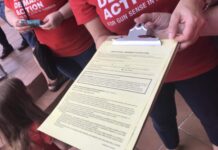In the face of the likely legalization of recreational cannabis in New York, a panel of experts from the state’s farming sector discussed what would help guarantee small farmers to get their fair share of the green rush.
The Dec. 11, 2018, discussion was part of the “Marijuana: Justice. Equity. Reinvestment” conference in Albany, New York, a two-day event hosted by the New York office of the Drug Policy Alliance (DPA).
“It’s a precarious time for farming around the country and in New York. A lot of family-scale farmers are struggling to be able to earn enough income from their land and their farming ventures to stay in business,” said Melissa Moore, deputy state director for the DPA and event moderator. “At the same time, cannabis is the fastest growing industry nationally, even outpacing tech, by the latest figures two to one.”
The discussions around legalization have tended to focus on the innovative tech sector and large population centers, but excluded small farmers in rural areas from the conversation, Moore said.
Indoor vs. Outdoor Growing
One reason for this is that indoor growing has taken center stage in states where cannabis is legal. In Massachusetts, for instance, all marijuana production is currently done indoors, according to panelist Kay Doyle, one of the state’s five cannabis control commissioners. The problem is often compounded, at least in Massachusetts, when local municipalities zone cannabis production in industrial zones rather than in rural areas where traditional farms are located.
Similarly, all the production of medical cannabis in New York currently comes from indoor growers.
California has seen a shift towards indoor cannabis production after adult-use marijuana became legal Jan. 1, 2018, according to panelist Kristin Nevedal, chair of the International Cannabis Farmers’ Association, an advocacy group for outdoor cannabis farmers. Nevedal has also been growing in Humboldt County, California, for the unregulated medical market for more than 20 years.
Based on her analysis, only about 5 percent of total cannabis production in the state is now coming from outdoor cultivation.“When the regulations are as expensive and onerous as what we see in California, families are driven from their farms,” Nevedal said.
Andi Novick, a New York lawyer and farmer who helped found the Small Farmers Alliance of Cannabis Growers, argued that indoor growing comes with adverse environmental effects.
“Indoor cannabis cultivation is one of the worst offenders of greenhouse gas emission,” Novick said. “It’s one of the most energy-intensive industries in the United States.”
Challenges for Small Farmers


There are significant barriers farmers who want to grow cannabis face, including the potential loss of federal farming subsidies, a lack of training, access to capital and to arable land.
Farmers who decide to cultivate cannabis could find themselves losing federal assistance, including farm loans and services, according to Doyle. “That’s a challenge for a lot of farmers,” she said. “They have to make a choice and that’s a difficult choice to make.”
The need for training and a lack of access to land and capital aren’t exclusive to cannabis production, according to panelist Jalal Sabur, a Hudson Valley vegetable farmer and activist. He said these are issues all small farmers face and are especially difficult for farmers of color.
Goldie Piff, a panelist and cannabis entrepreneur whose family has been farming in Massachusetts for more than 100 years, said access to land and capital for minority farmers was also an issue in her state.
“It’s hard as a person of color to go out and buy property. The prices for land in Massachusetts are outrageous, and then you need to be in a zoned area,” she said. “We need to work on zoning exclusions for small farmers to really produce and make a difference in our communities.”
Piff would also like to see money put behind small cannabis growers. “You have to understand what being a small farmer means. Our pockets just aren’t as deep as everyone else. We know the cannabis industry is going to be bringing in a lot of money, so why not put some of that money ahead so we can build a really solid foundation?”Another issue that needs to be addressed as New York moves into a regulated adult-use market is the health and safety of farmworkers, said Jose Chapa of the Rural & Migrant Ministry, a farm-workers’ rights organization. In light of the coming green rush, he urged passage of the farmworkers fair labor practices act that would guarantee farm workers things such as collective bargaining, overtime pay, and unemployment benefits.
Solutions
The panelists offered a variety of approaches on what New York’s adult-use cannabis regulations should look like in order to give smaller farmers a fighting chance in the recreational use market. They include:
- Implement municipal zoning exemptions for small outdoor growers so they could grow cannabis on the land they’re already farming.
- Create cannabis hubs, similar to food hubs that help connect farmers to consumers, through services such as shared distribution and marketing.
- Provide value-added opportunities for cannabis growers, such as allowing them to make cannabis-based salves and other products.
- Steer clear of a vertically integrated seed-to-sale system due to the high startup costs that create a barrier for small farmers.
- Establish craft cooperatives based on the model from Massachusetts that help create market entry opportunities and protect farmers from fallout. The craft cooperative is a type of cultivator that can grow, process, package and deliver cannabis products to other marijuana businesses, but not to consumers.











